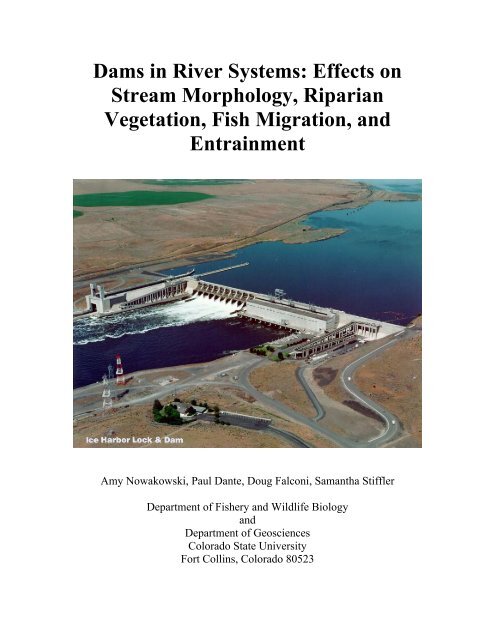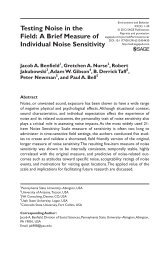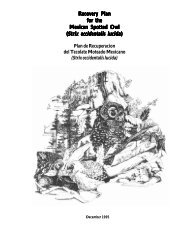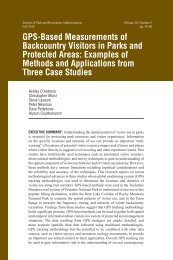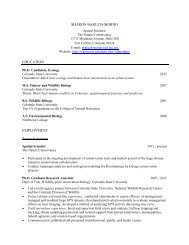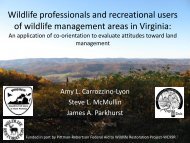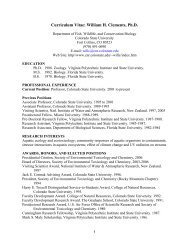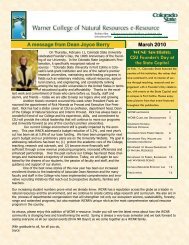Dams in River Systems - Warner College of Natural Resources ...
Dams in River Systems - Warner College of Natural Resources ...
Dams in River Systems - Warner College of Natural Resources ...
Create successful ePaper yourself
Turn your PDF publications into a flip-book with our unique Google optimized e-Paper software.
<strong>Dams</strong> <strong>in</strong> <strong>River</strong> <strong>Systems</strong>: Effects on<br />
Stream Morphology, Riparian<br />
Vegetation, Fish Migration, and<br />
Entra<strong>in</strong>ment<br />
Amy Nowakowski, Paul Dante, Doug Falconi, Samantha Stiffler<br />
Department <strong>of</strong> Fishery and Wildlife Biology<br />
and<br />
Department <strong>of</strong> Geosciences<br />
Colorado State University<br />
Fort Coll<strong>in</strong>s, Colorado 80523
Abstract.−<strong>Dams</strong> have harmful effects on<br />
river systems, because they disrupt<br />
stream morphology, riparian vegetation,<br />
fish migration, and cause fish<br />
entra<strong>in</strong>ment. <strong>Dams</strong> generate water<br />
temperature changes, reduce sediment<br />
transport, and alter flow regimes with<strong>in</strong><br />
a river system. Changes <strong>in</strong> flow regimes<br />
have adverse affects on native riparian<br />
vegetation recruitment. <strong>Dams</strong> deny fish<br />
access to critical upstream habitats, and<br />
have the potential to cause fish<br />
entra<strong>in</strong>ment. Multiple consequences are<br />
associated with entra<strong>in</strong>ment, <strong>in</strong>clud<strong>in</strong>g<br />
isolation <strong>of</strong> populations, prevent<strong>in</strong>g<br />
genetic exchange, block<strong>in</strong>g access to<br />
essential habitat, <strong>in</strong>jury, loss <strong>of</strong><br />
recruitment, potential <strong>in</strong>creased<br />
hybridization, and both direct and<br />
<strong>in</strong>direct mortality.<br />
<strong>Dams</strong> are <strong>in</strong>timately tied to river<br />
systems <strong>in</strong> North America, with<br />
approximately 79,000 dams currently<br />
exist<strong>in</strong>g <strong>in</strong> the United States (ASCE<br />
2005). Water storage, flood prevention,<br />
hydropower generation, irrigation,<br />
<strong>in</strong>dustrial use, and recreation are touted<br />
as benefits to dam construction.<br />
Unfortunately, most dams were built<br />
before research <strong>of</strong> the potential negative<br />
effects was <strong>in</strong>itiated. The goal <strong>of</strong> this<br />
paper is to assess disruptions <strong>in</strong> aquatic<br />
and riparian habitats caused by dams.<br />
Disruptions <strong>in</strong>clude changes <strong>in</strong> abiotic<br />
factors, such as water temperature,<br />
sediment transport, and flow regime.<br />
Biotic factors, <strong>in</strong>clud<strong>in</strong>g riparian<br />
vegetation recruitment, fish migration,<br />
and fish entra<strong>in</strong>ment, are also negatively<br />
<strong>in</strong>fluenced by dam constra<strong>in</strong>ts.<br />
Colorado pikem<strong>in</strong>now. Photo by Falconi. 2005.<br />
<strong>Dams</strong> <strong>in</strong> <strong>River</strong> <strong>Systems</strong>: Abiotic<br />
Factors and Stream Morphology<br />
by Amy Nowakowski<br />
The occurrence <strong>of</strong> dams <strong>in</strong> river<br />
systems has been widely studied to<br />
identify the relationships between dams,<br />
stream morphology, and the function <strong>of</strong><br />
aquatic and riparian ecosystems (Baxter<br />
1977; P<strong>of</strong>f et al. 1997; Graff 1999). The<br />
goal <strong>of</strong> this paper is to explore<br />
correlations between dams, water<br />
quality, sediment transport, flow regime,<br />
and the result<strong>in</strong>g disruptions <strong>of</strong> the river<br />
ecosystem. It is imperative to understand<br />
how dams affect the natural processes <strong>of</strong><br />
river systems so watershed managers can<br />
strive to ma<strong>in</strong>ta<strong>in</strong> ecosystem <strong>in</strong>tegrity<br />
while fulfill<strong>in</strong>g management activities<br />
(Hart and P<strong>of</strong>f 2002).<br />
<strong>Dams</strong> change aquatic habitat by<br />
alter<strong>in</strong>g water temperatures. Deep water<br />
stored beh<strong>in</strong>d a dam becomes stratified<br />
<strong>in</strong>to layers <strong>of</strong> differ<strong>in</strong>g temperatures<br />
(P<strong>of</strong>f and Hart 2002). When water is<br />
released from the dam, the cold<br />
hypolimnion layer flows downstream<br />
(American <strong>River</strong>s 2002). Aquatic<br />
species can reproduce, grow, and survive<br />
only with<strong>in</strong> a particular range <strong>of</strong><br />
temperatures (Kendeigh 1961). Changes<br />
<strong>in</strong> water temperature can lead to a shift<br />
<strong>in</strong> species composition or density, if<br />
<strong>in</strong>vad<strong>in</strong>g species overtake native species<br />
due to their higher range <strong>of</strong><br />
environmental tolerances (P<strong>of</strong>f and Hart<br />
2002).<br />
Sediment transport through a river<br />
system is also greatly affected by dams.<br />
Most sediment enter<strong>in</strong>g a reservoir is<br />
stored beh<strong>in</strong>d dams, result<strong>in</strong>g <strong>in</strong><br />
sediment-starved conditions downstream<br />
(Graf 2002). This creates the potential<br />
for channel <strong>in</strong>cision, bank erosion,<br />
change <strong>in</strong> channel planform, and<br />
development <strong>of</strong> a coarse armor layer on<br />
the streambed as f<strong>in</strong>e sediments wash
downstream (Knighton 1998; Graf 2002;<br />
Pizzuto 2002). A river system with a<br />
conf<strong>in</strong>ed sediment flow <strong>of</strong>ten has<br />
reduced habitat diversity due to the<br />
decreased nutrient flux and loss <strong>of</strong><br />
habitat (American <strong>River</strong>s 2002; Graf<br />
2002).<br />
The flow regime is a fundamental<br />
variable <strong>in</strong> the river ecosystem which is<br />
significantly disrupted by dams, thereby<br />
alter<strong>in</strong>g ecological <strong>in</strong>tegrity (Figure 1).<br />
Flow regimes provide the stream<br />
environment with naturally vary<strong>in</strong>g<br />
fluxes <strong>of</strong> both water and sediment,<br />
which def<strong>in</strong>e the stream morphology and<br />
the function <strong>of</strong> the stream ecosystem<br />
(P<strong>of</strong>f et al. 1997). In a natural river<br />
system, the diversity <strong>of</strong> flow conditions<br />
provide habitat for aquatic species<br />
(Newberry 1995), and riparian species<br />
dependent upon overbank floods (P<strong>of</strong>f<br />
and Hart 2002; American <strong>River</strong>s 2002).<br />
<strong>Dams</strong> constra<strong>in</strong> a river’s flow regime by<br />
stor<strong>in</strong>g water <strong>in</strong> reservoirs, limit<strong>in</strong>g<br />
overbank floods, and regulat<strong>in</strong>g and<br />
m<strong>in</strong>imiz<strong>in</strong>g the magnitude, frequency,<br />
duration, and tim<strong>in</strong>g <strong>of</strong> natural flows<br />
(Baxter 1977; P<strong>of</strong>f et al. 1997; P<strong>of</strong>f and<br />
Hart 2002). Consequently, the food web<br />
and productivity <strong>of</strong> species adapted to<br />
dynamic flow conditions is considerably<br />
modified by dams (P<strong>of</strong>f and Hart 2002).<br />
Figure 1.─Flow regime is <strong>of</strong> central importance <strong>in</strong> susta<strong>in</strong><strong>in</strong>g the ecological <strong>in</strong>tegrity <strong>of</strong> flow<strong>in</strong>g water<br />
systems. The five components <strong>of</strong> the flow regime–magnitude, frequency, duration, tim<strong>in</strong>g, and rate <strong>of</strong><br />
change–<strong>in</strong>fluence <strong>in</strong>tegrity both directly and <strong>in</strong>directly, through their effects on other primary regulators <strong>of</strong><br />
<strong>in</strong>tegrity. Modification <strong>of</strong> flow thus has cascad<strong>in</strong>g effects on the ecological <strong>in</strong>tegrity <strong>of</strong> rivers (from P<strong>of</strong>f et<br />
al. 1997; after Karr 1991).<br />
Although dam removal is a<br />
management option that can potentially<br />
reverse the morphological and ecological<br />
disruptions discussed above, little is<br />
known about the response <strong>of</strong> rivers to<br />
dam removal (P<strong>of</strong>f and Hart 2002;<br />
Stanley 2002; Doyle 2005; Santucci<br />
2005). Hart et al. (2002) provides a<br />
simple representation <strong>of</strong> the potential<br />
abiotic and biotic responses to dam<br />
removal (Figure 2). The potential<br />
responses to dam removal are time<br />
dependent, and may take days to several<br />
decades to respond. Therefore, it is a<br />
great challenge to predict the ecosystem<br />
response occurr<strong>in</strong>g after dam removal,<br />
because river ecosystems <strong>in</strong>volve a<br />
complexity <strong>of</strong> <strong>in</strong>teractions over a<br />
multitude <strong>of</strong> spatial and temporal scales<br />
(Hart et al. 2002).
Figure 2.─A simple spatial and temporal context for exam<strong>in</strong><strong>in</strong>g potential ecological responses to dam<br />
removal. Prior to removal, upstream and downstream free-flow<strong>in</strong>g areas are separated by an impoundment.<br />
Dam removal <strong>in</strong>itiates a series <strong>of</strong> abiotic and biotic changes that vary among areas and occur at different<br />
rates. For example, the rate <strong>of</strong> sediment transport and channel adjustment is a function <strong>of</strong> the distribution <strong>of</strong><br />
sediment particle sizes and flow magnitudes, and the response rate <strong>of</strong> aquatic and riparian biota to these<br />
changes depends on their dispersal and growth rates. Key changes occurr<strong>in</strong>g with<strong>in</strong> each spatial and<br />
temporal area have been highlighted. For some processes, arrows <strong>in</strong>dicate net change as either <strong>in</strong>crease<br />
( ↑ ) or decreases ( ↓ ), though <strong>in</strong> other cases the change may be <strong>in</strong> either direction ( ↑↓) (from Hart et al.<br />
2002).<br />
Riparian Response to Upstream Dam<br />
Creation<br />
by Paul Dante<br />
Riparian zones are a vital l<strong>in</strong>k to our<br />
river systems, be<strong>in</strong>g described by<br />
Naiman and Décamps (1997) as “some<br />
<strong>of</strong> the most diverse, dynamic, and<br />
complex biophysical habitats on the<br />
terrestrial portion <strong>of</strong> the planet.” Most<br />
<strong>of</strong> the research <strong>in</strong>to the effects <strong>of</strong> dams<br />
on riparian zones has occurred only<br />
with<strong>in</strong> the last two decades; however<br />
they are still <strong>of</strong>ten overlooked by the<br />
government, as well as the public. As<br />
approximately 79,000 dams are <strong>in</strong> the<br />
U.S. National Inventory <strong>of</strong> <strong>Dams</strong> (ASCE<br />
2005), any degradation or destruction <strong>of</strong><br />
riparian zones will cont<strong>in</strong>ue to be a<br />
problem <strong>in</strong> the United States for a long<br />
time to come. In this paper I will discuss<br />
the importance <strong>of</strong> riparian zones and<br />
describe some <strong>of</strong> the negative effects <strong>of</strong><br />
river regulation on these zones.<br />
Riparian corridors (or riparian zones),<br />
are the <strong>in</strong>terface between terrestrial and<br />
aquatic systems described by Lowrence<br />
et al. (1985, <strong>in</strong> Wenger 1999) as “the<br />
complex assemblage <strong>of</strong> organisms and<br />
their environment exist<strong>in</strong>g adjacent to<br />
and near flow<strong>in</strong>g water.” Naiman et al.<br />
(1993) ref<strong>in</strong>ed the def<strong>in</strong>ition to be the<br />
area between the low water marks and<br />
any areas above the high water mark<br />
affected by the heightened water table or<br />
regular flood<strong>in</strong>g, as well as “the ability<br />
<strong>of</strong> the soils to hold water”. Along with<br />
the trapp<strong>in</strong>g <strong>of</strong> sediment and pollutants,
iparian zones moderate water<br />
temperature, mitigate bank erosion and<br />
attenuate peak flows (Leavitt 1998;<br />
Wenger 1999). These attributes stabilize<br />
the ecology conditions <strong>of</strong> the stream, as<br />
well as help ma<strong>in</strong>ta<strong>in</strong> water quality for<br />
human and <strong>in</strong>dustrial use.<br />
Dam systems degradate riparian<br />
corridors for multiple reasons. <strong>Dams</strong><br />
fragment rivers by alter<strong>in</strong>g flow patterns,<br />
limit<strong>in</strong>g downstream movement <strong>of</strong><br />
sediment, and upstream and downstream<br />
movement biological material. Guppy<br />
(1906 <strong>in</strong> Merritt and Wohl 2006) and<br />
McAtee (1925 <strong>in</strong> Merritt and Wohl<br />
2006) noted the importance <strong>of</strong> plant<br />
hydrochory (dispersal by water) for<br />
riparian ecosystem health. Andersson et<br />
al. (2000) and Merritt and Wohl (2002)<br />
found that dam fragmentation <strong>of</strong> rivers<br />
blocks transport, decreas<strong>in</strong>g the<br />
effectiveness <strong>of</strong> hydrochory <strong>of</strong> the seeds<br />
and other vegetative propagules.<br />
Bradley and Smith (1986) found that<br />
cottonwood (Populus sp.) seed dispersal,<br />
which is timed around natural peak<br />
floods, had decreased effectiveness<br />
under regulated flow that altered peak<br />
tim<strong>in</strong>g. Merritt and Cooper (2000)<br />
found that the spr<strong>in</strong>g flood peak <strong>of</strong> the<br />
Green <strong>River</strong> <strong>of</strong> northwest Colorado was<br />
completely removed by river regulation,<br />
and as a result, riparian Populus<br />
recruitment has been elim<strong>in</strong>ated.<br />
Riparian vegetation (Al-Kaisi 2000).<br />
Along with removal <strong>of</strong> peak flow,<br />
related changes <strong>in</strong> the water table may<br />
affect riparian health. Dur<strong>in</strong>g the 37<br />
years after the <strong>in</strong>troduction <strong>of</strong> the<br />
Flam<strong>in</strong>g Gorge dam on the Green <strong>River</strong>,<br />
there was a transition <strong>in</strong> riparian<br />
vegetation that seems to <strong>in</strong>dicate a shift<br />
to shrublands from Populus, and an<br />
<strong>in</strong>crease <strong>of</strong> fluvial marshes (Merritt and<br />
Cooper 2000) (Figure 1). This may<br />
<strong>in</strong>dicate a change <strong>in</strong> available water.<br />
Riparian cottonwood and willow (Salix<br />
sp.) dependence on shallow alluvial<br />
groundwater make them extremely<br />
susceptible to water table changes<br />
(Aml<strong>in</strong> and Rood 2002; Rood et al.<br />
2003). Reduction <strong>in</strong> water table height<br />
can be lethal to seedl<strong>in</strong>gs, and thus limit<br />
or prevent recruitment <strong>of</strong> new trees<br />
(Rood and Mahoney 1990; Segelquist et<br />
al. 1993).<br />
Until regulated rivers are allowed to<br />
return to more natural flow patterns,<br />
riparian zones <strong>in</strong> the United States will<br />
cont<strong>in</strong>ue to degrade, and with them the<br />
ecological health <strong>of</strong> these river. That is<br />
why it is important for research to<br />
cont<strong>in</strong>ue to delve <strong>in</strong>to the requirements<br />
<strong>of</strong> riparian zones and for local, state, and<br />
federal governmental agencies to take<br />
this <strong>in</strong>formation <strong>in</strong>to account when<br />
establish<strong>in</strong>g flow regulation.
Figure 1.─Model <strong>of</strong> channel response to flow regulation on the Green <strong>River</strong> <strong>in</strong> Browns Park from 1938<br />
through the present, <strong>in</strong>ferred from planform geometry. Frame (a) shows the pre-dam quasi-equilibrium<br />
meander<strong>in</strong>g channel prior to regulation. Stage I: frame (b) shows the short-term (1966–1977) narrow<strong>in</strong>g<br />
response <strong>of</strong> the channel to reduced flow; note the establishment <strong>of</strong> vegetation <strong>in</strong> the formerly active<br />
channel. Stage II and III: frames (c) and (d) illustrate the longer-term (1977–1994) channel response, which<br />
<strong>in</strong>cludes the development <strong>of</strong> bars, the stabilization <strong>of</strong> bars to form islands, and the cont<strong>in</strong>ued widen<strong>in</strong>g <strong>of</strong><br />
the channel. Frame (e) is the hypothetical long-term form <strong>of</strong> the channel after several more decades <strong>of</strong><br />
widen<strong>in</strong>g, the coalescence <strong>of</strong> islands through channel <strong>in</strong>fill<strong>in</strong>g, and formation <strong>of</strong> a meander<strong>in</strong>g channel<br />
with<strong>in</strong> the newly formed floodpla<strong>in</strong> nested with<strong>in</strong> the high banks <strong>of</strong> the former floodpla<strong>in</strong>. (from Merritt<br />
and Cooper 2000).
Instream Barriers: Prevent<strong>in</strong>g Fishes<br />
From Access<strong>in</strong>g Upstream Habitats<br />
by Douglas A. Falconi<br />
The most important effect <strong>of</strong> all<br />
<strong>in</strong>stream barriers is to prevent upstream<br />
movement <strong>of</strong> fishes (Baxter 1977).<br />
Instream barriers have had the most<br />
noticeable impact on diadromous fishes<br />
(Table 1; Leggett 1977; P<strong>of</strong>f et al. 1997).<br />
However, many river<strong>in</strong>e fishes that were<br />
once considered to be residents have<br />
now been observed to require many<br />
kilometers <strong>of</strong> unobstructed stream to<br />
fulfill their life cycle (W<strong>in</strong>ston et al.<br />
1991; Gowan et al. 1994; Gowan and<br />
Fausch 1996; Fausch et al. 2002).<br />
Although fish passageways have been<br />
implemented at some dams to restore<br />
partial connectivity, they may not be<br />
adequate for all species to access<br />
upstream habitat (Clay 1995; Beasley<br />
and Hightower 2000; Moser et al. 2000).<br />
Only removal <strong>of</strong> <strong>in</strong>stream barriers will<br />
restore connectivity.<br />
Table 1.─Some common diadromous fishes <strong>of</strong> North America that are impeded by <strong>in</strong>stream barriers and<br />
native occurrence (modified from Lucas and Baras 2001).<br />
Species<br />
Common Name Scientific Name<br />
Atlantic or<br />
Pacific<br />
Atlantic sea lamprey Petromyzon mar<strong>in</strong>us Atlantic<br />
Arcitic lamprey Petromyzon japonica Pacific<br />
American Atlantic sturgeon Acipenser oxyr<strong>in</strong>chus Atlantic<br />
shortnose sturgeon Acipenser brevirostrum Atlantic<br />
alewife Alosa psuedoharengus Atlantic<br />
blueback herr<strong>in</strong>g Alosa aestivalis Atlantic<br />
American shad Alosa sapidissima Atlantic<br />
delta smelt Hypomesus transpacificus Pacific<br />
ch<strong>in</strong>ook salmon Oncorhynchus tshawytscha Pacific<br />
Atlantic salmon Salmo salar Atlantic<br />
coho salmon Oncorhynchus kisutch Pacific<br />
chum salmon Oncorhynchus keta Pacific<br />
p<strong>in</strong>k salmon Oncorhynchus gorbuscha Pacific<br />
striped bass Morone saxatilis Atlantic<br />
white perch Morone americana Atlantic<br />
On the East Coast, the presence <strong>of</strong><br />
<strong>in</strong>stream barriers has prevented<br />
American shad Alosa sapidissima from<br />
access<strong>in</strong>g natal spawn<strong>in</strong>g sites (Rohde et<br />
al. 1994; Beasley and Hightower 2000).<br />
Beasley and Hightower (2000) observed<br />
striped bass Morone saxatilis us<strong>in</strong>g the<br />
denil passageway at the Quaker Neck<br />
Dam, but American shad rema<strong>in</strong>ed at the<br />
base <strong>of</strong> the dam. When the Quaker Neck<br />
Dam was removed <strong>in</strong> 1998, both striped<br />
bass and American shad were observed<br />
spawn<strong>in</strong>g <strong>in</strong> upstream habitats (Beasley<br />
and Hightower 2000). For passageway<br />
design, fish lifts have been most<br />
successful for American shad (Barry and<br />
Kynard 1986; Spankle 2005). The Essex<br />
Dam fish lifts on the Merrimack <strong>River</strong> <strong>in</strong><br />
Massachusetts passed 5,283 American<br />
shad, or 10% <strong>of</strong> the run, <strong>in</strong> 2002<br />
(Spankle 2005). A common means <strong>of</strong><br />
passage for American shad on East<br />
Coast rivers has been the use <strong>of</strong>
navigation locks (Moser et al. 2000;<br />
Bailey et al. 2004). For example, on the<br />
Cape Fear <strong>River</strong> <strong>in</strong> North Carol<strong>in</strong>a, 3 <strong>of</strong><br />
66 (4.5%) radio-tagged American shad<br />
used the denil passageway, whereas 28<br />
out <strong>of</strong> 66 (42%) passed upstream us<strong>in</strong>g<br />
the navigation lock (Moser et al. 2000).<br />
Bailey et al. (2004) observed that 50% <strong>of</strong><br />
the American shad that returned to the<br />
New Savannah Bluff Lock and Dam on<br />
the Savannah <strong>River</strong> <strong>in</strong> Georgia also<br />
passed upstream us<strong>in</strong>g the navigation<br />
lock.<br />
The effects <strong>of</strong> diversion dams and<br />
<strong>in</strong>stream barriers are not limited to<br />
diadromous fishes. Many <strong>in</strong>land fishes<br />
have also been severely impacted. In the<br />
Colorado <strong>River</strong> Bas<strong>in</strong>, <strong>in</strong>stream barriers<br />
are a ma<strong>in</strong> cause for the decl<strong>in</strong>e <strong>of</strong><br />
Colorado pikem<strong>in</strong>now, Ptychocheilus<br />
lucius (M<strong>in</strong>ckley 1973; Tyus 1986).<br />
White <strong>River</strong> resident Colorado<br />
pikem<strong>in</strong>now migrate over 600 km <strong>in</strong> the<br />
Green <strong>River</strong> Bas<strong>in</strong> to one <strong>of</strong> two<br />
spawn<strong>in</strong>g areas year after year (Tyus and<br />
McAda 1984; Tyus 1986, 1990; Irv<strong>in</strong>g<br />
and Modde 2000). Instream barriers, like<br />
the Taylor Draw Dam on the White<br />
<strong>River</strong>, prevent <strong>in</strong>dividuals from<br />
access<strong>in</strong>g potential spawn<strong>in</strong>g areas and<br />
w<strong>in</strong>ter<strong>in</strong>g habitat (Tyus 1986; Burdick<br />
1995; Irv<strong>in</strong>g and Modde 2000).<br />
Construct<strong>in</strong>g passageways may be a<br />
viable recovery option for this species.<br />
Burdick (2001) observed several subadult<br />
and adult Colorado pikem<strong>in</strong>now<br />
use a newly constructed vertical slot<br />
passageway at the Redlands Diversion<br />
Dam on the Gunnison <strong>River</strong> near Grand<br />
Junction, Colorado.<br />
Clearly, <strong>in</strong>stream barriers have<br />
negative effects on the native<br />
ichthy<strong>of</strong>auna <strong>of</strong> streams by prevent<strong>in</strong>g<br />
upstream access to spawn<strong>in</strong>g sites and<br />
w<strong>in</strong>ter<strong>in</strong>g habitats (Tyus 1986, 1990;<br />
Beasley and Hightower 2000; Irv<strong>in</strong>g and<br />
Modde 2000). Install<strong>in</strong>g passageways<br />
may help some species to use historic<br />
habitat, but the efficiency <strong>of</strong> a<br />
passageway is very difficult to calculate,<br />
so the degree <strong>of</strong> success <strong>of</strong>ten rema<strong>in</strong>s<br />
uncerta<strong>in</strong> (Clay 1995). Only complete<br />
removal will ensure that all species are<br />
able to freely migrate upstream.<br />
Salmon attempt migration over <strong>in</strong>stream barrier<br />
(LCS 2001).<br />
Environmental Effects and Potential<br />
Consequences <strong>of</strong> Fish Entra<strong>in</strong>ment<br />
by Samantha Stiffler<br />
Entra<strong>in</strong>ment <strong>of</strong> fish at power plant<br />
and other water <strong>in</strong>takes has the potential<br />
to adversely affect fish populations.<br />
Jude et al. (1986, <strong>in</strong> Savitz et al. 1998)<br />
described entra<strong>in</strong>ment as the process <strong>of</strong><br />
an organism pass<strong>in</strong>g through a plant and<br />
be<strong>in</strong>g discharged back <strong>in</strong>to the<br />
environment. Multiple consequences are<br />
associated with entra<strong>in</strong>ment: isolation <strong>of</strong><br />
populations, prevent<strong>in</strong>g genetic
exchange, block<strong>in</strong>g access to essential<br />
habitat, <strong>in</strong>jury, loss <strong>of</strong> recruitment,<br />
potential <strong>in</strong>creased hybridization, and<br />
both direct and <strong>in</strong>direct mortality<br />
(USFWS 2001).<br />
Degree <strong>of</strong> impacts on populations<br />
depends on fish species and <strong>in</strong>take<br />
characteristics. Species specific effects<br />
depend on: motility; physiological and<br />
behavioral responses; vertical and<br />
horizontal distribution <strong>in</strong> vic<strong>in</strong>ity to the<br />
<strong>in</strong>take, and growth rate, which<br />
determ<strong>in</strong>es the period <strong>of</strong> vulnerability to<br />
entra<strong>in</strong>ment. Intake characteristics<br />
<strong>in</strong>clude: location and construction<br />
details, which control flow conditions <strong>in</strong><br />
the immediate vic<strong>in</strong>ity <strong>of</strong> the <strong>in</strong>take; size<br />
<strong>of</strong> structure; discharge volume; type <strong>of</strong><br />
release; and depth <strong>of</strong> turb<strong>in</strong>es (Boreman<br />
1977; Travnichek et al. 1993).<br />
Multiple studies have shown that the<br />
majority <strong>of</strong> organisms entra<strong>in</strong>ed are<br />
young-<strong>of</strong>-year or juveniles (Gray et al.<br />
1986; Jaeger et al. 2005; New York<br />
Power Authority 2005). Larval drift<br />
obta<strong>in</strong>s a maximum peak dur<strong>in</strong>g the<br />
early days or weeks <strong>of</strong> life, and primarily<br />
occurs at night, with a maximum shortly<br />
after dusk (Figure 1), and <strong>in</strong> some cases,<br />
close to dawn (Carter and Reader 2000).<br />
Determ<strong>in</strong><strong>in</strong>g the number <strong>of</strong> fish<br />
entra<strong>in</strong>ed is difficult; to determ<strong>in</strong>e<br />
percent loss, the average concentration<br />
<strong>of</strong> organisms <strong>in</strong> the water, mortality <strong>of</strong><br />
entra<strong>in</strong>ed organisms, and period <strong>of</strong><br />
vulnerability to entra<strong>in</strong>ment must be<br />
taken <strong>in</strong>to account (Boreman 1977). The<br />
effect on larvae entra<strong>in</strong>ed is also<br />
particularly difficult to determ<strong>in</strong>e<br />
because larvae abundance, mortality, and<br />
growth are difficult to estimate (Jensen<br />
1990).<br />
Figure 1.─Diel Variation <strong>in</strong> (a) entra<strong>in</strong>ment and (b) drift <strong>of</strong> 0+ fish, on two dates, <strong>in</strong> the <strong>River</strong> Trent,<br />
England. (BST = British Summer Time; from Carter and Reader 2000).
Legislation <strong>in</strong>volved with<br />
entra<strong>in</strong>ment <strong>in</strong>volves state and federal<br />
requirements. Under section 316(b) <strong>of</strong><br />
the Clean Water Act, cool<strong>in</strong>g water<br />
<strong>in</strong>take structures are required to reflect<br />
the best technology available for<br />
m<strong>in</strong>imiz<strong>in</strong>g adverse environmental<br />
impacts (W<strong>in</strong>kle and Kadvany 2003).<br />
This section evaluates water <strong>in</strong>takes and<br />
documents permits after the evaluation is<br />
approved (Ed<strong>in</strong>ger and Kolluru 2000).<br />
In addition to state requirements, the<br />
National Oceanic and Atmospheric<br />
Adm<strong>in</strong>istration Fisheries and the US<br />
Fish and Wildlife Service <strong>of</strong>ten require<br />
screen<strong>in</strong>g to protect fish species listed as<br />
threatened or endangered. Justification<br />
for these screen<strong>in</strong>gs result from the<br />
removal <strong>of</strong> threatened or endangered<br />
species by a diversion constitut<strong>in</strong>g<br />
“take” under section 4(d) <strong>of</strong> the<br />
Endangered Species Act (Moyle and<br />
Israel 2005).<br />
Various technologies have been<br />
developed to attempt to reduce<br />
entra<strong>in</strong>ment. These barriers have been<br />
divided <strong>in</strong>to physical and behavioral<br />
barriers. The Federal Energy Regulatory<br />
Commission (1995, <strong>in</strong> New York Power<br />
Authority 2005) report five types <strong>of</strong><br />
physical barriers that have been<br />
deployed at hydroelectric stations: low<br />
velocity fish screens, high velocity fish<br />
screens, close-spaced and angled bar<br />
racks, louvers, and barrier nets.<br />
Behavioral barriers <strong>in</strong>clude: lights, such<br />
as strobe and mercury, which have<br />
variable response rates (McK<strong>in</strong>stry et al.<br />
2005; Johnson et al. 2005), sound, air<br />
bubble curta<strong>in</strong>s, and electrical barriers<br />
(New York Power Authority 2005).<br />
Entra<strong>in</strong>ment can be compared to<br />
natural mortality; if the rate <strong>of</strong><br />
entra<strong>in</strong>ment is small and less than<br />
natural mortality, the impact would not<br />
be appreciably noticeable. However, if<br />
the rate exceeds natural mortality, the<br />
population may not be susta<strong>in</strong>able<br />
(Ed<strong>in</strong>ger and Kolluru 2000).<br />
Percentage <strong>of</strong> entra<strong>in</strong>ment from a s<strong>in</strong>gle<br />
<strong>in</strong>take may be low, but cumulative<br />
impacts could be high (Ed<strong>in</strong>ger and<br />
Kolluru 2000). Population-level<br />
responses may be characterized by a<br />
significant time lag, where effects would<br />
not be seen for many years. In turn,<br />
ecosystem-level effects, such as size and<br />
structure <strong>of</strong> populations, are likely to<br />
become evident with cont<strong>in</strong>ued<br />
population changes caused by<br />
entra<strong>in</strong>ment (Benstead et al. 1999).<br />
Conclusion<br />
One management option that has<br />
potential to mediate the adverse effects<br />
<strong>of</strong> dams <strong>in</strong> river systems is dam removal.<br />
Dam removal can restore aquatic and<br />
riparian habitats by reestablish<strong>in</strong>g the<br />
natural flow regime, allow<strong>in</strong>g fish<br />
migration, and elim<strong>in</strong>at<strong>in</strong>g entra<strong>in</strong>ment<br />
occurrences. However, abiotic and biotic<br />
responses to dam removal are difficult to<br />
predict because complex <strong>in</strong>teractions<br />
occur over different spatial and temporal<br />
scales.<br />
Removal <strong>of</strong> low-head dam on the Ashuelot<br />
<strong>River</strong>, New Hampshire (USFWS 2005).
References<br />
Al-Kaisi, M. 2000. Conservation buffers<br />
and water quality. Integrated Crop<br />
Management. Available:<br />
www.ent.iastate.edu/.../buffer/buffer.<br />
html. (April 2006).<br />
American <strong>River</strong>s. 2002. The ecology <strong>of</strong><br />
dam removal: a summary <strong>of</strong> benefits<br />
and impacts. Available:<br />
http://www.americanrivers.org/site/<br />
DocServer/ ecology<strong>of</strong><br />
damremoval.pdf?docID=494. (March<br />
2006).<br />
Aml<strong>in</strong>, N.M., and S.B. Rood. 2002.<br />
Comparative tolerances <strong>of</strong> riparian<br />
willows and cottonwoods to watertable<br />
decl<strong>in</strong>e. Wetlands 22(2):338–<br />
346.<br />
Andersson, E., C. Nilsson, and M.E.<br />
Johansson. 2000. Effects <strong>of</strong> river<br />
fragmentation on plant dispersal and<br />
riparian flora. Regulated <strong>River</strong>s:<br />
Research and Management 16:83–<br />
89.<br />
[ASCE] American Society <strong>of</strong> Civil<br />
Eng<strong>in</strong>eers. 2005. National<br />
Infrastructure Report Card.<br />
Available:<br />
http://www.asce.org/reportcard/2005<br />
/page.cfm?id=23. (February 2006).<br />
Bailey, M.M., J.J. Isely, and W.C.<br />
Bridges, Jr. 2004. Movement and<br />
population size <strong>of</strong> American shad<br />
near a low-head lock and dam.<br />
Transactions <strong>of</strong> the American<br />
Fisheries Society. 133:300-308.<br />
Barry, T., and B. Kynard. 1986.<br />
Attraction <strong>of</strong> adult American shad to<br />
fish lifts at Holyoke Dam,<br />
Connecticut <strong>River</strong>. North American<br />
Journal <strong>of</strong> Fisheries Management.<br />
6:233-241.<br />
Baxter, R. M. 1977. Environmental<br />
effects <strong>of</strong> dams and impoundments.<br />
Annual Review <strong>of</strong> Ecology and<br />
Systematics 8:255-283.<br />
Beasley, C.A., and J.E. Hightower.<br />
2000. Effects <strong>of</strong> a low-head dam on<br />
the distribution and characteristics <strong>of</strong><br />
spawn<strong>in</strong>g habitat used by striped<br />
bass and American shad.<br />
Transactions <strong>of</strong> the American<br />
Fisheries Society. 129:1316-1330.<br />
Benstead, J.P., J.G. March, C.M.<br />
Pr<strong>in</strong>gle, and F.N. Scatena. 1999.<br />
Effects <strong>of</strong> a low-head dam and water<br />
abstraction on migratory tropical<br />
stream biota. Ecological<br />
Applications 9:656-668.<br />
Boreman, J. 1977. Impacts <strong>of</strong> power<br />
plant <strong>in</strong>take velocities on fish. Fish<br />
and Wildlife Service. US<br />
Department <strong>of</strong> the Interior. Fish and<br />
Wildlife resources and electric power<br />
generation. Report no. 1. Ann<br />
Arbor, Michigan.<br />
Bradley, C.E., and D.G. Smith. 1986.<br />
Pla<strong>in</strong>s cottonwood recruitment and<br />
survival on a prairie meander<strong>in</strong>g<br />
river floodpla<strong>in</strong>, Milk <strong>River</strong>,<br />
southern Alberta and northern<br />
Montana. Canadian Journal <strong>of</strong><br />
Botany 64:1433-1442.<br />
Burdick, B.D. 1995. Ichthy<strong>of</strong>aunal<br />
studies <strong>of</strong> the Gunnison <strong>River</strong>,<br />
Colorado, 1992 -1994. U.S. Fish and<br />
Wildlife Service, Asp<strong>in</strong>all Unit<br />
Umbrella Studies Recovery Program<br />
Project 42, Grand Junction,<br />
Colorado.<br />
Burdick, B.D. 2001. Five-year<br />
evaluation <strong>of</strong> fish passage at the<br />
Redlands Diversion Dam on the<br />
Gunnison <strong>River</strong> near Grand Junction,<br />
Colorado: 1996 – 2000. U.S. Fish<br />
and Wildlife Service, Recovery<br />
Program Project CAP-4b, Grand<br />
Junction, Colorado.
Carter, K.L., and JP Reader. 2000.<br />
Patterns <strong>of</strong> drift and power station<br />
entra<strong>in</strong>ment <strong>of</strong> 0+ fish <strong>in</strong> the <strong>River</strong><br />
Trent, England. Fisheries<br />
Management and Ecology 7:447-<br />
464.<br />
Clay, C.H. 1995. Design <strong>of</strong> fishways and<br />
other fish facilities. Second Edition.<br />
CRC Press, Boca Raton, Florida.<br />
Doyle, M.W., E.H. Stanley, C.H. Orr,<br />
A.R. Selle, S.A. Sethi, and J.M.<br />
Harbor. 2005. Stream ecosystem<br />
response to small dam removal:<br />
lessons from the heartland.<br />
Geomorphology 71:227-244.<br />
Ed<strong>in</strong>ger, J.E., and VS Kolluru. 2000.<br />
Power plant <strong>in</strong>take entra<strong>in</strong>ment<br />
analysis. Journal <strong>of</strong> Energy<br />
Eng<strong>in</strong>eer<strong>in</strong>g 1:1-14.<br />
Fausch, K.D., C.E. Torgersen, C.V.<br />
Baxter, and H.W. Li. 2002. A<br />
cont<strong>in</strong>uous view <strong>of</strong> the river is<br />
needed to understand how processes<br />
<strong>in</strong>teract<strong>in</strong>g among scales set the<br />
context for stream fishes and their<br />
habitat. BioScience. 52:483-498.<br />
Gowan, C., and K.D. Fausch. 1996.<br />
Mobile brook trout <strong>in</strong> two high<br />
elevation Colorado streams: reevaluat<strong>in</strong>g<br />
the concept <strong>of</strong> restricted<br />
movement. Canadian Journal <strong>of</strong><br />
Fisheries and Aquatic Science.<br />
53:1370-1381.<br />
Gowan, C., M.K. Young, K.D. Fausch,<br />
and S.C. Riley. 1994. Restricted<br />
movement <strong>in</strong> resident stream<br />
salmonids: a paradigm lost?<br />
Canadian Journal <strong>of</strong> Fisheries and<br />
Aquatic Science. 51:2626-2637.<br />
Graf, W.L. 1999. Dam nation: a<br />
geographic census <strong>of</strong> American dams<br />
and their large-scale hydrologic<br />
impacts. Water <strong>Resources</strong> Research<br />
35:1305-1311.<br />
Graf, W.L., editor. 2002. Dam removal<br />
research status and prospects.<br />
Proceed<strong>in</strong>gs <strong>of</strong> the He<strong>in</strong>z Center’s<br />
Dam Removal Research Workshop.<br />
The H. John He<strong>in</strong>z III Center for<br />
Science, Economics and the<br />
Environment. Wash<strong>in</strong>gton, D.C.<br />
Gray, R.H., T.L. Page, D.A. Neitzel, and<br />
D.D. Dauble. 1986. Assess<strong>in</strong>g<br />
population effects from entra<strong>in</strong>ment<br />
<strong>of</strong> fish at a large volume water<br />
<strong>in</strong>take. Journal <strong>of</strong> Environmental<br />
Science and Health A21:191-209.<br />
Hart, D.D., Johnson T.E., Bushaw-<br />
Newton K. L., Horwitz R. J.,<br />
Bednarek A. T., Charles D. F.,<br />
Kreeger D. A., and D. J. Vel<strong>in</strong>sky.<br />
2002. Dam removal: challenges and<br />
opportunities for ecological research<br />
and river restoration. BioScience<br />
52:669-681.<br />
Hart, D.D., and N.L. P<strong>of</strong>f. 2002. A<br />
special section on dam removal and<br />
river restoration. BioScience 52:653-<br />
655.<br />
Irv<strong>in</strong>g, D.B., and T. Modde. 2000. Home<br />
range fidelity and use <strong>of</strong> historic<br />
habitat by adult Colorado<br />
pikem<strong>in</strong>now (Ptychocheilus lucius)<br />
<strong>in</strong> the White <strong>River</strong>, Colorado and<br />
Utah. Western North American<br />
<strong>Natural</strong>ist. 60:16-25.<br />
Jaeger, M.E., A.V. Zale, T.E. McMahon,<br />
and B.J. Schmitz. 2005. Seasonal<br />
movements, habitat use, aggregation,<br />
exploitation, and entra<strong>in</strong>ment <strong>of</strong><br />
saugers <strong>in</strong> the Lower Yellowstone<br />
<strong>River</strong>: an empirical assessment <strong>of</strong><br />
factors affect<strong>in</strong>g population<br />
recovery. North American Journal<br />
<strong>of</strong> Fisheries Management 25:1550-<br />
1568.<br />
Jensen, A.L. 1990. Estimation <strong>of</strong><br />
recruitment forgone result<strong>in</strong>g from<br />
larval fish entra<strong>in</strong>ment. Journal <strong>of</strong><br />
Great Lakes <strong>Resources</strong> 16:241-244.<br />
Johnson, P.N., K. Bouchard, and F.A.<br />
Goetz. 2005. Effectiveness <strong>of</strong> strobe
lights for reduc<strong>in</strong>g juvenile salmonid<br />
entra<strong>in</strong>ment <strong>in</strong>to a navigation lock.<br />
North American Journal <strong>of</strong> Fisheries<br />
Management 25:491-501.<br />
Karr, J.R. 1991. Biological <strong>in</strong>tegrity: a<br />
long-neglected aspect <strong>of</strong> water<br />
resource management. Ecological<br />
Applications 1:66-84.<br />
Kendeigh, W.C. 1961. Animal ecology.<br />
Prentice-Hall. Englewood Cliffs,<br />
New Jersey.<br />
Knighton, D. 1998. Fluvial forms and<br />
processes. Oxford University Press,<br />
New York.<br />
[LCS] Ludlow Civic Society. 2001.<br />
Available:<br />
web.onetel.com/~jagludlow/waterme<br />
adows.htm. (April 2006).<br />
Leavitt, J. 1998. The functions <strong>of</strong><br />
riparian buffers <strong>in</strong> urban watersheds.<br />
Master’s Thesis. University <strong>of</strong><br />
Wash<strong>in</strong>gton, Seattle.<br />
Leggett, W.C. 1977. The ecology <strong>of</strong> fish<br />
migrations. Annual Review <strong>of</strong><br />
Ecology and Systematics. 8:285-308.<br />
Lucas, M.C., and E. Baras. 2001.<br />
Migration <strong>of</strong> freshwater fishes.<br />
Blackwell Science, London,<br />
England.<br />
McK<strong>in</strong>stry, C.A., M.A. Simmons, C.S.<br />
Simmons, and R.L. Johnson. 2005.<br />
Statistical assessment <strong>of</strong> fish<br />
behavior from split-beam hydroacoustic<br />
sampl<strong>in</strong>g. Fisheries<br />
Research 72:29-44.<br />
Merritt, D.M., and D.J. Cooper. 2000.<br />
Riparian vegetation and channel<br />
change <strong>in</strong> response to river<br />
regulation: a comparative study <strong>of</strong><br />
regulated and unregulated streams <strong>in</strong><br />
the Green <strong>River</strong> bas<strong>in</strong>, USA.<br />
Regulated <strong>River</strong>s: Research and<br />
Management 22:1–26.<br />
Merritt, D.M., and E.E. Wohl. 2002.<br />
Processes govern<strong>in</strong>g hydrochory<br />
along rivers: hydraulics, hydrology,<br />
and dispersal phenology. Ecological<br />
Applications 12:1071–1087.<br />
Merritt, D.M., and E.E. Wohl. 2006.<br />
Plant dispersal along rivers<br />
fragmented by dams. <strong>River</strong> Research<br />
and Applications 16:543–564.<br />
M<strong>in</strong>ckley, W.L. 1973. Fishes <strong>of</strong> Arizona.<br />
Arizona Game and Fish Department,<br />
Phoenix, Arizona.<br />
Moser, M.L., A.M. Darazsdi, and J.R.<br />
Hall. 2000. Improv<strong>in</strong>g passage<br />
efficiency <strong>of</strong> adult American shad at<br />
low-elevation dams with navigation<br />
locks. North American Journal <strong>of</strong><br />
Fisheries Management. 20:376-385.<br />
Moyle, P.B., and J.A. Israel. 2005.<br />
Untested assumptions: effectiveness<br />
<strong>of</strong> screen<strong>in</strong>g diversions for<br />
conservation <strong>of</strong> fish populations.<br />
Fisheries 30:20-25.<br />
Naiman, R.J., and H. Décamps. 1997.<br />
The ecology <strong>of</strong> <strong>in</strong>terfaces: riparian<br />
zones. Annual Review <strong>of</strong> Ecology<br />
and Systematics. 28:621-658.<br />
Naiman, R.J., H. Décamps, and M.<br />
Pollock. 1993. The role <strong>of</strong> riparian<br />
corridors <strong>in</strong> ma<strong>in</strong>ta<strong>in</strong><strong>in</strong>g regional<br />
biodiversity. Ecological<br />
Applications 3:209-212.<br />
Newberry, R. 1995. <strong>River</strong>s and the art <strong>of</strong><br />
stream restoration. <strong>Natural</strong> and<br />
anthropogenic <strong>in</strong>fluences <strong>in</strong> fluvial<br />
geomorphology: Geophysical<br />
Monograph 89:137-149.<br />
New York Power Authority. 2005. Fish<br />
entra<strong>in</strong>ment and mortality study.<br />
Niagara Power Project FERC No.<br />
2216. White Pla<strong>in</strong>s, New York<br />
Pizzuto, J. 2002. Effects <strong>of</strong> dam removal<br />
on river form and process.<br />
BioScience 52:683-691.<br />
P<strong>of</strong>f, N.L., J.D. Allen, M.B. Ba<strong>in</strong>, J.R.<br />
Karr, K.L. Prestegaard, B.D.<br />
Richter, R.E. Sparks, and J.C.<br />
Stromberg. 1997. The natural flow<br />
regime: a paradigm for river
conservation and restoration.<br />
Bioscience 47:769–784.<br />
P<strong>of</strong>f, N.L., and D.D. Hart. 2002. How<br />
dams vary and why it matters for the<br />
emerg<strong>in</strong>g science <strong>of</strong> dam removal.<br />
BioScience 52:659-668.<br />
Rago, P.J. 1984. Production forgone: An<br />
alternative method for assess<strong>in</strong>g the<br />
consequences <strong>of</strong> fish entra<strong>in</strong>ment<br />
and imp<strong>in</strong>gement losses at power<br />
plants and other water <strong>in</strong>takes.<br />
Ecological Model<strong>in</strong>g 24:79-111.<br />
Rohde, F.C., R.G. Arndt, D.G.<br />
L<strong>in</strong>dquist, and J.F. Parnell. 1994.<br />
Freshwater fishes <strong>of</strong> the Carol<strong>in</strong>as,<br />
Virg<strong>in</strong>ia, Maryland, and Delaware.<br />
The University <strong>of</strong> North Carol<strong>in</strong>a<br />
Press. USA.<br />
Rood, S.B., J.H. Braatne, and F.M.R.<br />
Hughes. 2003 Ecophysiology <strong>of</strong><br />
riparian cottonwoods: stream flow<br />
dependency, water relations and<br />
restoration. Tree Physiology<br />
23:1113–1124.<br />
Rood, S.B., and J.M. Mahoney. 1990.<br />
Collapse <strong>of</strong> riparian poplar forests<br />
downstream from dams <strong>in</strong> western<br />
prairies: probable causes and<br />
prospects for mitigation.<br />
Environmental Management 14:451–<br />
464.<br />
Santucci, V.J., Jr., S.R. Gephard, and S.<br />
M. Pescitelli. 2005. Effects <strong>of</strong><br />
multiple low-head dams on fish,<br />
macro<strong>in</strong>vertebrates, habitat, and<br />
water quality <strong>in</strong> the Fox <strong>River</strong>,<br />
Ill<strong>in</strong>ois. North American Journal <strong>of</strong><br />
Fisheries Management 25:975–992.<br />
Savitz, J., L.G. Bardygula-Nonn, R.A.<br />
Nonn, and G. Wojtowicz. 1998.<br />
Imp<strong>in</strong>gement and entra<strong>in</strong>ment <strong>of</strong><br />
fishes with<strong>in</strong> a high volume-low<br />
velocity deep water <strong>in</strong>take system on<br />
Lake Michigan. Journal <strong>of</strong><br />
Freshwater Ecology 13:165-169.<br />
Segelquist, C.A., M.L. Scott, and G.T.<br />
Auble. 1993. Establishment <strong>of</strong><br />
Populus deltoids under simulated<br />
alluvial groundwater decl<strong>in</strong>es.<br />
American Midland <strong>Natural</strong>ist<br />
130:274-285.<br />
Spankle, K. 2005. Interdam movements<br />
and passage attraction <strong>of</strong> American<br />
shad <strong>in</strong> the lower Merrimack <strong>River</strong><br />
ma<strong>in</strong> stem. North American Journal<br />
<strong>of</strong> Fisheries Management. 25:1456-<br />
1466.<br />
Stanley, E.H., M.A. Luebke, M.W.<br />
Doyle, and D.W. Marshall. 2002.<br />
Short-term changes <strong>in</strong> channel form<br />
and macro<strong>in</strong>vertebrate communities<br />
follow<strong>in</strong>g low-head dam removal.<br />
Journal <strong>of</strong> the North American<br />
Benthological Society 21:172-187.<br />
Travnichek, V.H., A.V. Zale, and W.L.<br />
Fisher. 1993. Entra<strong>in</strong>ment <strong>of</strong><br />
ichthyoplankton by a warmwater<br />
hydroelectric facility. Transactions<br />
<strong>of</strong> the American Fisheries Society<br />
122:709-716.<br />
Tyus, H.M. 1986. Life strategies <strong>in</strong> the<br />
evolution <strong>of</strong> the Colorado squawfish<br />
(Ptychocheilus lucius). Great Bas<strong>in</strong><br />
<strong>Natural</strong>ist. 46:656-661.<br />
Tyus, H.M. 1990. Potamodromy and<br />
reproduction <strong>of</strong> Colorado squawfish<br />
<strong>in</strong> the Green <strong>River</strong> Bas<strong>in</strong>, Colorado<br />
and Utah. Transactions <strong>of</strong> the<br />
American Fisheries Society.<br />
119:1035-1047.<br />
Tyus, H.M., and C.W. McAda. 1984.<br />
Migration, movements and habitat<br />
preferences <strong>of</strong> Colorado squawfish,<br />
Ptychocheilus lucius, <strong>in</strong> the Green,<br />
White, and Yampa <strong>River</strong>s, Colorado<br />
and Utah. The Southwestern<br />
<strong>Natural</strong>ist. 29:289-299.<br />
[USFWS] (United States Fish and<br />
Wildlife Service). 2001.<br />
Biological/Conference Op<strong>in</strong>ion<br />
regard<strong>in</strong>g the effects <strong>of</strong> long term
operation <strong>of</strong> the Bureau <strong>of</strong><br />
Reclamation’s Klamath Project on<br />
the Endangered Lost <strong>River</strong> sucker<br />
(Deltistes luxatus), Endangered<br />
shortnose sucker (Chasmistes<br />
brevirostris), Threatened BALD<br />
EAGLE (Haliaeetus leucocephalus),<br />
and proposed critical habitat for the<br />
Lost <strong>River</strong> and shortnose suckers.<br />
US Fish and Wildlife Service,<br />
Klamath Falls, OR.<br />
[USFWS] United States Fish and<br />
Wildlife Service. 2005. Connecticut<br />
<strong>River</strong> Coord<strong>in</strong>ator’s Office:<br />
Restor<strong>in</strong>g migratory fish to the<br />
Connecticut <strong>River</strong> bas<strong>in</strong>. Available:<br />
http://www.fws.gov/r5crc/Habitat/fis<br />
h_passage.htm. (April 2006).<br />
Wenger, S. 1999. A review <strong>of</strong> the<br />
scientific literature on riparian buffer<br />
width, extent and vegetation. Office<br />
<strong>of</strong> Public Service & Outreach,<br />
Institute <strong>of</strong> Ecology, University <strong>of</strong><br />
Georgia, Athens.<br />
W<strong>in</strong>kle, W.V., and J. Kadvany. 2003.<br />
Model<strong>in</strong>g fish entra<strong>in</strong>ment and<br />
imp<strong>in</strong>gement impacts: bridg<strong>in</strong>g<br />
science and policy. Pages 46-69 <strong>in</strong><br />
V.H. Dale, editor. Ecological<br />
model<strong>in</strong>g for resource management.<br />
Spr<strong>in</strong>ger-Verlage, New York.<br />
W<strong>in</strong>ston, M.R., C.M. Taylor, and J.<br />
Pigg. 1991. Upstream extirpation <strong>of</strong><br />
four m<strong>in</strong>now species due to<br />
damm<strong>in</strong>g <strong>of</strong> a prairie stream.<br />
Transactions <strong>of</strong> the American<br />
Fisheries Society. 120:98-105.


